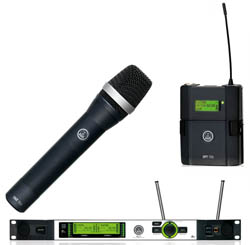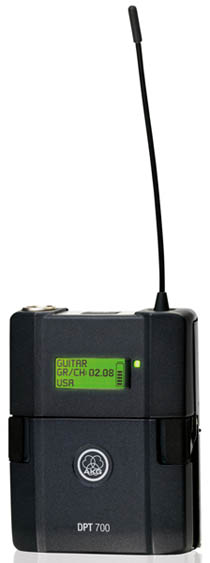A number of manufacturers have introduced new wireless microphone systems in the past two years – many of them in response to the changes in the RF spectrum brought about by the FCC.
As a result, I thought it would be interesting to provide an in-depth look at a number of these recently introduced systems, beginning here with the AKG DMS 700 digital wireless system, which was announced at NAMM in January of this year.
Professional caliber digital wireless systems have been on the market for several years, as evidenced by offerings from Telex, Zaxcom, and Lectrosonics (to name a few off the top of my head). Mipro also introduced a digital system within the past couple of years, and the Sennheiser Digital 1000 system was introduced way back around the year 2000, although I guess some might argue that it’s not a true “pro” system.
AKG’s effort with digital wireless with the more recent DMS 700 provides users with some important advancements and merits a detailed look.
The Basics
The DMS 700 consists of three main products: a handheld transmitter, a bodypack transmitter, and the dual-channel rack-mount receiver.
Interestingly, this system is designed to operate in the standard UHF spectrum, covering two ranges – between 548 MHz and 698 MHz for the U.S. and other markets where this range is legal; and between 710 MHz and 865 MHz for Europe or other markets where this range is legal.
The first thing to note is that DMS 700 covers a very wide range of 155 MHz – most UHF systems cover somewhere between 25 MHz and 90 MHz per unit. This very wide tuning range allows up to 100 channels to be in use simultaneously.
Usually, there’s a trade-off between how wide of a band is covered and noise from the PLL (phase locked loop). But in theory, a digital system would not suffer from this noise issue.
That said, the DMS 700 is still an RF device, and thus 155 MHz is a lot of UHF spectrum, with a lot of high-energy sources (NTSC/PAL and DTV broadcasts). Yet because this system is digital, it’s modulation scheme will discriminate between “good” and “bad” data, and/or unwanted data.
.
Even further along these lines, the receiver comes with an “Environment Scan” function that converts it into a spectrum analyzer. It searches the receiver’s entire frequency band for active radio frequencies and shows them in a frequency spectrum graph on the front panel display.
Specs
Several of the specifications for the DMS 700 are impressive, while others are standard for high-quality wireless. Audio frequency response is specified as 25 Hz to 20 kHz, ±3 dB, which is only matched by other digital or “digital hybrid” systems.
One problem with any analog-based frequency-agile wireless system is that the PLL does not allow for frequencies below about 20 Hz to pass, otherwise the PLL itself will “unlock” and the system will become unusable until power cycled.
Thus, typically a high-pass filter is installed to cut the audio below say 40 or 50 Hz. So to have flat response down to 25 Hz is the domain of digital-only systems.
.
The inclusion of AES-3 digital outputs on the DSR 700 receiver is something we’re starting to see (also found in Sennheiser’s EM3732 receiver, although it is an analog system with an A to D converter and DSP-based compander) and should be a nice way to interface with digital consoles.
By connecting via the digital outputs, the DSR 700 exhibits 120 dB signal-to-noise, which is impressive.
Another feature that is appearing on the horizon for receivers is the Ethernet connection so that control of the receiver can be executed as part of a PC network. Sennheiser and Shure have started doing this as well, and we can expect other manufacturers to follow suit.
The transmitters appear to be of standard size and shape from the outside, but also have some less commonly-seen features.
First, they offer switchable transmit power levels covering 10, 20, 30 and 50 mW. Although we’ve seen this in isolated cases before, usually in the form of “high and low power” like 10 mW and 50 mW, for instance, it’s nice to see a range of powers available on tap.
This also of course reflects that these products are planned for sale in a variety of countries where different power levels are specified by law. The U.S. allows 250 mW in the UHF band, but most of Europe allows just 50 mW while Japan and Korea allow only 10 mW.
Then there are market-specific needs, such as theater where power in the 20 to 50 mW range is desired due to the density of wireless channels in a small geographic area, such as the Broadway area of New York City.
RF power can also affect battery drain, so in cases where long battery life is needed, such as more rurally located churches where high power is not helpful, a 10 mW setting can be perfect.
.
The DHT 700 handheld transmitter is available with a choice of either an AKG D 5 (dynamic) or C 5 (condenser) mic element; a wide range of AKG headworn, instrument, and lavalier microphones can be used with the DPT 700 bodypack transmitter.
One last feature that is only available to fully digital wireless systems is data encryption. Although systems from Lectrosonics and Telex have included encryption in their digital systems in the past, the inclusion of it in the DMS 700 makes this product available to a sector of the market usually reserved for specialized systems.
CostInterestingly, the cost of the DMS 700 is attractive in comparison with other top wireless systems. The handheld and belt pack transmitters both carry a U.S. MSRP of $999, and the receiver is $1,699 (again, U.S. MSRP). Thus a DMS 700 system with two transmitters has an MSRP of less than $3,700.
Conclusion
All in all, this appears to be quite an interesting system and should be a viable choice for many different applications. The cost aspect makes it even more attractive in terms of the sheer variety of features coupled with the level of performance offered by AKG in the DMS 700 system.
Find out more about the DMS 700 here.
Signing off for now…
Mike Wireless
Mike Wireless is the nom de plume of a long-time RF geek devoted to better entertainment wireless system practices the world over.
.
.
Other posts by Mike Wireless:
Is The UHF Spectrum Going To Ease Up After June 12?
Change The Only Constant In Marketplace For Wireless System Spectrum



















